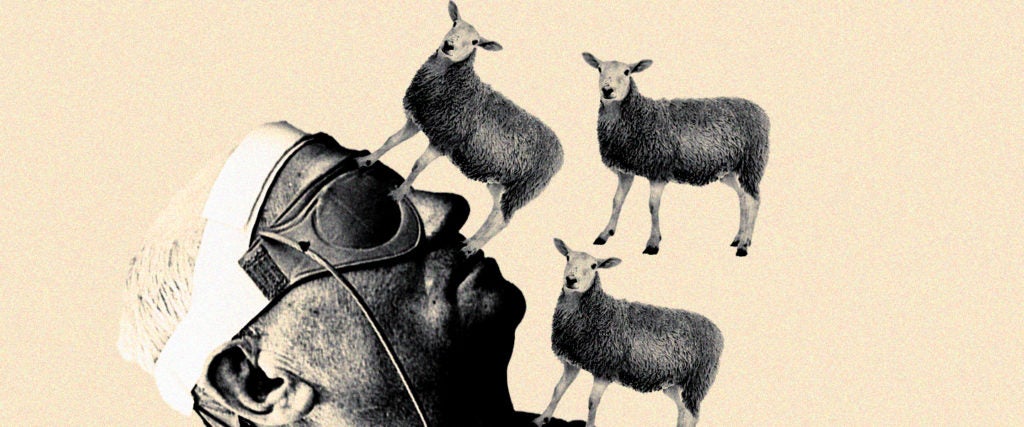When Martin Reed first emigrated to the U.S. from the U.K. in 2008, he failed to adjust to the initial jet lag. His sleepless nights, however, only snowballed from there. And eventually, he fell victim to the very thing that makes insomnia stick — the fear that he’d never get a good night’s sleep again. Like a baseball player with “the yips,” Reed’s inability to sleep had morphed into a kind of performance anxiety.
Generally speaking, by the time someone experiences insomnia for several months, common solutions based on sleep hygiene — e.g., limiting screen time and caffeine, and making your room dark, quiet and comfortable — stop working because such bedtime routines feel like preparation for an all-night fight.
Me: “I’ll do anything to cure my insomnia.”
Expert: “Limit caffeine or alcohol or screen time.”
Me: “I shall forever suffer in the cruel, incurable grasp of insomnia.”— Bess Kalb (@bessbell) December 6, 2018
Everyone talk about the Early bird gets the worm but I don’t see a damn one of y’all worried about that worm’s incurable insomnia.
— Matt Dawson (@SaintRPh) October 15, 2020
“Sleep responds negatively to effort — if we put effort into sleep, we make sleep more difficult,” explains Reed, a now-reformed insomniac turned certified clinical sleep health educator. “So when someone with insomnia adds all these new rituals to their lives in a bid to improve their sleep and they don’t work, they can become even more worried about their sleep, perpetuating sleep disruption.”
Psychiatrist and sleep medicine specialist Alex Dimitriu agrees, describing insomnia as “a finger-trap problem, where the harder you force sleep, the worse sleep can be.” This is why many doctors are careful to clinically diagnose insomnia, preferring instead to focus on the main symptom of not being able to fall or stay asleep. “If the diagnosis of insomnia induces anxiety, it may hurt more than help,” Dimitriu says.
when you have anxiety that keeps you up so you become sleep deprived and because you’re sleep deprived you get more anxious and because you got more anxious you can’t sleep from insomnia
Unfortunately, that hasn’t stopped many people from self-diagnosing themselves as insomniacs. According to the strict scientific criteria — in short, difficulty falling and staying asleep for at least three nights a week for more than three months, or sleep loss that significantly impairs day-to-day functioning and cannot be explained by medication, other diagnoses like bipolar disorder or substance abuse — about one out of 10 of us meet the insomnia diagnosis. Still, research shows that as many as one out three people report having insomnia.
Much of the recent cultural obsession with sleep started after Arianna Huffington’s TED Talk in 2010, which turned rest into a symbol of success. The trend helped sell premium mattresses, blackout curtains, sleeping pills and copies of Huffington’s book, The Sleep Revolution: Transforming Your Life, One Night at a Time. As such, the global sleep market is now worth approximately $432 billion. Not that any of it is helping; many experts argue that our sleep is worse than ever. In fact, one study found that the number of working adults who sleep inadequately increased from 30 percent in 2010 to 35.6 percent in 2018.
But when people finally do get help, they’re in such a state of hyper-arousal and exhaustion that they struggle to tolerate the one evidence-based treatment that’s been found to correct the negative thought-spiral that fuels insomnia: cognitive behavioral therapy for insomnia, or CBT-I. Before addressing sleep hygiene, CBT-I helps individuals with insomnia change how they think about sleep. Known as cognitive restructuring, it starts with identifying problematic beliefs someone might have about the topic. For instance, if a person goes to bed thinking they won’t be able to work effectively, feel healthy or get along with other people if they don’t fall asleep by a certain time, CBT-I helps shift their thinking in a more constructive direction, like “my body knows how to get the rest it needs and tomorrow will be fine.”
The thing is, for people who haven’t slept well in a long time, a new way of thinking can be a tough sell. “That’s why Ambien is more popular than a good sleep schedule — it’s a quick fix,“ Dimitriu says. Ambien, though, has dangerous side effects like sleep walking and the risk of developing a dependence. Not to mention, Ambien isn’t approved for long-term use. (CBT-I takes about six to eight weeks to produce noticeable results.)
As for Reed, once he convinced himself that sleep wasn’t the elusive white whale he made it out to be, he was able to actually do it — and sleep hygiene slowly started to be more effective. “We tend only to see and hear about people struggling with sleep, which can give the impression that it’s incurable when that isn’t the case,” Reed says. “Insomnia is absolutely curable, as we’ve seen with countless studies that have evaluated the efficacy of CBT-I. I promise, nobody is beyond help.”

